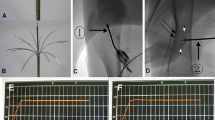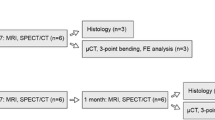Abstract
Objective
To evaluate the heat effects of radiofrequency ablation (RFA) on normal bone by mechanical testing, MRI, and histology.
Materials and methods
The institutional animal care and use committee approved the animal study. Thirty-two adult Japanese white rabbits were included in our study. Bone biopsy needles were inserted from the distal end of the right (RFA side) and the left (control side) femurs using a fluoroscopic guide. A 17-gauge internally cooled RFA electrode with a 2-cm active tip was inserted through the needle to the right femur, and RFA was performed for 12 min using a 200-W generator. Animals were divided into four groups and 8 animals from each group were euthanized on day 1, day 7, day 30, and day 60 after RFA. MRI was performed prior to euthanasia. Three-point bending test was performed to measure flexural strength. Student’s t test was used to evaluate for significant differences between RFA and control side for each group. Femurs underwent histological examination by hematoxylin and eosin staining after the bending test.
Results
MRI showed a high-intensity rim around the bone on T2WI. Three-point bending test showed no statistically significant differences (P < 0.05) between the RFA and the control side in any of the groups. Histologically, osteocytes of cortical bone showed cell death, but the lamellar structure was preserved in all groups and bone remodeling was observed.
Conclusion
Heat by RFA did not change normal bone strength within 2 months, despite the heat effects in the cortical bone and cell death.







Similar content being viewed by others
References
Rosenthal DI, Alexander A, Rosenberg AE, Springfield D. Ablation of osteoid osteomas with a percutaneously placed electrode: a new procedure. Radiology. 1992;183(1):29–33.
Rosenthal DI, Hornicek FJ, Torriani M, Gebhardt MC, Mankin HJ. Osteoid osteoma: percutaneous treatment with radiofrequency energy. Radiology. 2003;229(1):171–5.
Hoffmann RT, Jakobs TF, Kubisch CH, et al. Radiofrequency ablation in the treatment of osteoid osteoma-5-year experience. Eur J Radiol. 2010;73(2):374–9.
Callstrom MR, Charboneau JW, Goetz MP, et al. Painful metastases involving bone: feasibility of percutaneous CT- and US-guided radio-frequency ablation. Radiology. 2002;224(1):87–97.
Goetz MP, Callstrom MR, Charboneau JW, et al. Percutaneous image-guided radiofrequency ablation of painful metastases involving bone: a multicenter study. J Clin Oncol. 2004;22(2):300–6.
Cantwell CP, Flavin R, Deane R, et al. Radiofrequency ablation of bone with cooled probes and impedance control energy delivery in a pig model: MR imaging features. J Vasc Interv Radiol. 2007;18(8):1011–20.
Dierselhuis EF, Jutte PC, van der Eerden PJ, Suurmeijer AJ, Bulstra SK. Hip fracture after radiofrequency ablation therapy for bone tumors: two case reports. Skeletal Radiol. 2010;39(11):1139–43.
Earhart J, Wellman D, Donaldson J, Chesterton J, King E, Janicki JA. Radiofrequency ablation in the treatment of osteoid osteoma: results and complications. Pediatr Radiol. 2013;43(7):814–9.
Adachi A, Kaminou T, Ogawa T, et al. Heat distribution in the spinal canal during radiofrequency ablation for vertebral lesions: study in swine. Radiology. 2008;247(2):374–80.
McGahan JP, Loh S, Boschini FJ, et al. Maximizing parameters for tissue ablation by using an internally cooled electrode. Radiology. 2010;256(2):397–405.
Beaupied H, Lespessailles E, Benhamou CL. Evaluation of macrostructural bone biomechanics. Joint Bone Spine. 2007;74(3):233–9.
Akhter MP, Iwaniec UT, Covey MA, Cullen DM, Kimmel DB, Recker RR. Genetic variations in bone density, histomorphometry, and strength in mice. Calcif Tissue Int. 2000;67(4):337–44.
Goss PE, Qi S, Josse RG, et al. The steroidal aromatase inhibitor exemestane prevents bone loss in ovariectomized rats. Bone. 2004;34(3):384–92.
Lopez MJ, Markel MD. Bending tests of bone. In: An YH, Draughn RA, editors. Mechanical testing of bone and the bone-implant interface. Boca Raton: CRC Press; 2000. p. 207–17.
Herrmann NP, Bennett JL. The differentiation of traumatic and heat-related fractures in burned bone. J Forensic Sci. 1999;44(3):461–9.
Goldberg SN, Gazelle GS, Halpern EF, Rittman WJ, Mueller PR, Rosenthal DI. Radiofrequency tissue ablation: importance of local temperature along the electrode tip exposure in determining lesion shape and size. Acad Radiol. 1996;3(3):212–8.
Martel J, Bueno A, Dominguez MP, Llorens P, Quiros J, Delgado C. Percutaneous radiofrequency ablation: relationship between different probe types and procedure time on length and extent of osteonecrosis in dog long bones. Skeletal Radiol. 2008;37(2):147–52.
Sans N, Galy-Fourcade D, Assoun J, Jarlaud T, et al. Osteoid osteoma: CT-guided percutaneous resection and follow-up in 38 patients. Radiology. 1999;212(3):687–92.
Coleman RE. Management of bone metastases. Oncologist. 2000;5(6):463–70.
Coleman RE. Bisphosphonates: clinical experience. Oncologist. 2004;9 Suppl 4:14–27.
Toyota N, Naito A, Kakizawa H, et al. Radiofrequency ablation therapy combined with cementoplasty for painful bone metastases: initial experience. Cardiovasc Interv Radiol. 2005;28(5):578–83.
Lee JM, Choi SH, Park HS, et al. Radiofrequency thermal ablation in canine femur: evaluation of coagulation necrosis reproducibility and MRI—histopathologic correlation. AJR Am J Roentgenol. 2005;185(3):661–7.
Nour SG, Aschoff AJ, Mitchell IC, Emancipator SN, Duerk JL, Lewin JS. MR imaging-guided radio-frequency thermal ablation of the lumbar vertebrae in porcine models. Radiology. 2002;224(2):452–62.
Spadaro JA, Werner FW, Brenner RA, Fortino MD, Fay LA, Edwards WT. Cortical and trabecular bone contribute strength to the osteopenic distal radius. J Orthop Res. 1994;12(2):211–8.
Wachter NJ, Krischak GD, Mentzel M, et al. Correlation of bone mineral density with strength and microstructural parameters of cortical bone in vitro. Bone. 2002;31(1):90–5.
Reisinger AG, Pahr DH, Zysset PK. Principal stiffness orientation and degree of anisotropy of human osteons based on nanoindentation in three distinct planes. J Mech Behav Biomed Mater. 2011;4(8):2113–27.
Agerbaek MO, Eriksen EF, Kragstrup J, Mosekilde L, Melsen F. A reconstruction of the remodelling cycle in normal human cortical iliac bone. Bone Miner. 1991;12(2):101–12.
Eriksen EF, Gundersen HJ, Melsen F, Mosekilde L. Reconstruction of the formative site in iliac trabecular bone in 20 normal individuals employing a kinetic model for matrix and mineral apposition. Metab Bone Dis Relat Res. 1984;5(5):243–52.
Acknowledgements
The authors would like to thank Shinsaku Yata, Akira Adachi, Tsuyoshi Kawai, Masayuki Endo, Shohei Takasugi, Takahiro Akao, and Hisataka Tanaka for their editorial assistance in preparing the manuscript.
Conflict of interest
The authors declare that they have no conflict of interest.
Author information
Authors and Affiliations
Corresponding author
Rights and permissions
About this article
Cite this article
Yamamoto, S., Kaminou, T., Ono, Y. et al. Thermal influence of radiofrequency ablation for bone: an experimental study in normal rabbit bone. Skeletal Radiol 43, 459–465 (2014). https://doi.org/10.1007/s00256-013-1807-0
Received:
Revised:
Accepted:
Published:
Issue Date:
DOI: https://doi.org/10.1007/s00256-013-1807-0




